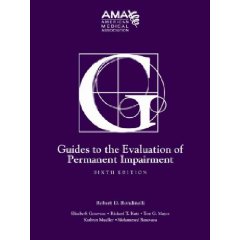Guides to the Evaluation of Permanent Impairment, sixth edition, emphasizes the fundamental skills physicians need to
evaluate and communicate patient impairments.
Standardized methodology is applied to each chapter to enhance the relevancy of impairment ratings, improve internal
consistency and promote ease of application to the rating process. This ordered method enables busy physicians to
become proficient with the ratings for multiple organ systems and anticipate how each chapter is organized and
assimilates information.
The sixth edition applies both terminology from and an analytical framework based on the International Classification
of Functioning, Disability and Health (ICF), to generate five impairment classes which permit the rating of the patient
from no impairment to most severe. A diagnosis-based grid has been developed for each organ system. The grid arranges
commonly used ICD-9 diagnoses within the five classes of impairment severity, according to the consensus-based dominant
criterion.
Functionally based histories, physical findings and broadly accepted objective clinical test results are integrated
where applicable to help physicians determine the grade within the impairment class. The result is a decision that is
both transparent and reproducible.
Using the latest evidence in diagnosis and clinical tests, the new sixth edition offers the following key features:
Standardized approach across organ systems and chapters
Expanded use of diagnostic approach to help physicians consider relevant clinical tests and patient outcomes in
performing the rating
Required clinical information needed to rate a given condition
Clear step-by-step grading instructions in each chapter to promote consistent scoring of impairment ratings and to
improve physician consistency
Simplified methodology presented between chapters
Contemporary, evidence-based concepts and terminology of disablement from the ICF
The latest scientific research and evolving medical opinion provided by nationally and internationally recognized
experts
More comprehensive and expanded diagnostic approach
Transparent process to allow the evaluator to document functional assessment, clinical tests and physical findings
Uniform grids to help physicians calculate impairment ratings


